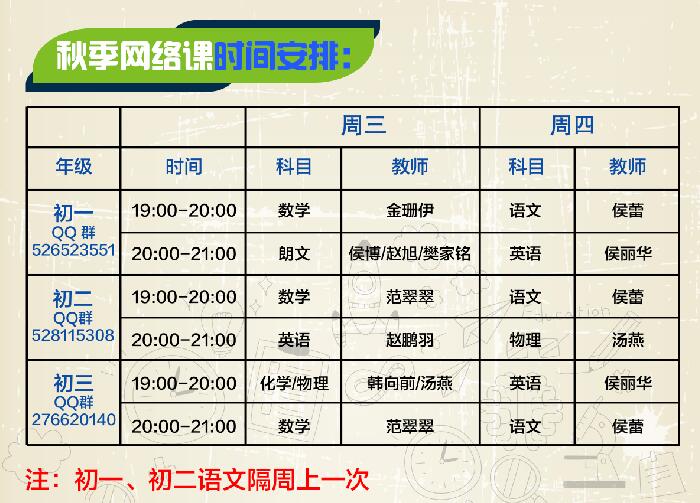[初中英语]初一英语语法大全
2016-09-30 10:27
来源:新东方
作者:新东方
新东方免费网络公益网络课程QQ群
初一QQ群:526523551 初二QQ群:528115308 初三QQ群:276620140
初一英语语法大全
构成语言的三要素:语音,词汇,语法。英语也是由这三个要素组成的,缺一不可。没有语法只能传达很少的信息,因为词汇知识一个个孤立的组成部分,没有语法的词汇就如没有树干和树枝的树叶,知识一片零散的叶子。
语法,顾名思义,就是语言的法则和规律。
英语毕竟不是我们的母语,和汉语史完全不同的语言体系,因此这两种语言之间的差距十分巨大,在西关表达和思维方式上在很多时候都相差甚远。
如,我们中国的学生在表达中经常会出现一些这样的错误:
1,I very like English.
(违背了英语语法规则,副词修饰动词要放在动词后面)
2,I live in a large house has garden.
I like play computer games.
(违背英语语法规则:一个英语句子中不能出现两个谓语动词)
3,iI have three pen.
(违背英语语法规则:可数名词复数要变成相应的复数形式)
好多同学在使用英语时常发生忽略英语名词的单复数,不注意动词的时态变化,而且在搭配上常发生搭配错误。
语法是组织字词句段的关键。好的语法可以使英文文章写的更流畅,有亮点,思路清晰,不容易产生歧义。而且就我的感受来说,语法好从某种意义上来说也影响你的英语口语,是你的语言更具逻辑性,辩证性,所以英语语法的学习对我们整个英语知识的掌握和运用都有着现实的意义。
初一英语语法大全,其中包括
主要掌握几种时态
1,一般现在时
2,一般过去时
3,一般将来时
4,现在进行时
还有几种词
1,名词
2,代词
3,形容词
4,动词
5,冠词
初一英语语法
一、词类
学习词类的重要性
在学习英语单词时必须同时掌握单词的"音、形、义、类、用"。
"音"就是读音,
"形"就是拼法,即"spelling",
"义"就是词义,
"类"就是词类,
"用"就是用法、搭配习惯。
单词的词性往往决定了它的用法,也就是决定了它在句子当中所起的作用。
学习名词的时候,要关心它是可数名词或是不可数名词;学习动词的时候,
要关心它是及物动词还是不及物动词,它是延续性动词还是短暂性动词;
等等。正如上面所述。一个词常常兼有不同的词类,而辨别词类只能在句
子当中进行。所以在掌握单词的时候最好结合例句进行效果往往更好。
根据语法功能,词可以分为十类:名词、代词、数词、形容词、副词、动词、冠词、介词、连词和感叹词。
1、名词
名词指用来表示人、事物、地点、时间、事件及抽象概念等名称的词。
A、名词的数
我们知道名词可以分为可数名词和不可数名词,而不可数名词它没有复数形式,但可数名词却有单数和复数之分,复数的构成如下:
一、规则变化:
1.在后面加s。如:fathers, books, Americans, Germans, apples, bananas
2.x, sh, ch, s, tch后加es。如:
box-----boxes glasse-------glasses dress-----dresses
Watch-----watches wish------- wishes fax-------faxes
3.1)以辅音字母加y结尾的变y为i再加es 如:
baby-----babies family------families duty------duties
comedy----comedies story-----stories
2)以元音字母加y结尾的直接加s。如:
day----days boy------boys toy-------toys key------keys,
way---ways body----bodys
4.以o结尾加s(外来词)。如:radios, photos,
但如是辅音加o的加es:如:
tomato-----tomatoes西红柿 potato-------potatoes马铃薯 ,土豆
negro----negroes黑人 hero---------heroes英雄
黑人英雄爱吃西红柿和马铃薯。
The negroes heroes like potatoes and tomatoes.
5.以f或fe结尾的变f为v再加es(s)。如:
knife---knives wife----wives half----halves
shelf----shelves leaf----leaves yourself----yourselves
巧计以-f(e)结尾的名词复数
树叶半数自己黄,妻子拿刀去割粮
架后窜出一只狼,就像强盗逃命忙
Leaf(树叶),half(一半)、self(自己)、wife(妻子)、knife(刀子)、shelf(架子)、wolf(狼)、thief(盗贼,强盗)、life(生命)变复数时,都要变-f(e)为v,再加-es.其他的以-f(e)结尾的名词则直接加-s变复数。
二、不规则变化:
英语中有少数名词不是通过在词尾加-s或-es构成复数形式,而是由自己独特的复数构成形式。
1).含有man的名词,变a为e.
man ---------------men男人 woman-------women女人
Policeman----- policemen 警察 Englishman-----Englishmen英国人
2).含有oo的名词,变oo为ee.
tooth---------teeth牙齿 foot-------feet 脚
goose--------geese 鹅
3).变换词尾的复数变化
child-------children孩子 ox-------oxen公牛 mouse-------mice老鼠
4).单复数相同(不变的)有:
fish, sheep, deer鹿, Chinese, Japanese,means方法 ,works工厂
三、复合名词的复数变化规则:
合成的复数一般只加主要名词,多数为后一个单词。
如:action movie-------action movies pen pal--------pen pals;
但如果是由man或woman所组成的合成词的复数则同时为复数。
如:man doctor---------men doctors woman teacher---------women teachers
四、单复数相同(不变的)有:fish, sheep, deer鹿子, Chinese, Japanese
五、一般只有复数,没有单数的有:people, pants, shorts, shoes, glasses, gloves, clothes, socks
六、单词形式不变,既可以是单数也可以是复数的有:police警察局,警察, class班,同学, family家,家庭成员
七、有的单复数意思不同。如:
fish鱼 fishes鱼的种类, paper纸 papers报纸,卷子,论文,
work工作 works作品,工厂, glass玻璃 glasses玻璃杯,眼镜,
orange桔子水 oranges橙子, light光线 lights灯,
people人 peoples民族, time时间 times时代, 次数,
chicken 鸡肉 chickens 小鸡
课堂练习:
请把下列名词的单数形式变为相应的复数形式:
1.bag----- 2.teacher------- 3.bus------
4.box----- 5.baby------ 6.factory-----
7.body----- 8.leaf----- 9.potato-----
10.photo----- 11.Franchman----- 12.tooth-----
13.child----- 14.mouse----- 15.sheep-----
B. 名词的格
当我们要表示某人的什么东西或人时,我们就要使用所有格形式。构成如下:
一)单数在后面加’s。如:brother’s, Mike’s, teacher’s
二)复数以s结尾的直接在s后加’,如果不是以s结尾的与单数一样处理。如:
Teachers’ Day教师节, classmates’; Children’s Day六一节, Women’s Day三八节
三)由and并列的名词所有时,如果是共同所有同一人或物时,只加最后一个’s,但分别拥有时却分别按单数形式处理。如:
Mike and Ben’s room迈克和本的房间(共住一间),
Mike’s and Ben’s rooms迈克和本的房间(各自的房间)
2、代词
代词是用来代替名词或名词短语的词。使用代词可以使句子重复,使句子简洁化。
一、英语人称代词(含反身代词)表
|
英语8个人称代词 |
|||||
|
单数 |
主格 |
宾格 |
形容词性物主代词 |
名词性物主代词 |
反身代词 |
|
I 我 |
me我 |
my我的 |
mine我的(东西) |
myself我自己 |
|
|
you你 |
you你 |
your你的 |
yours你的(东西) |
yourself你自己 |
|
|
he他 |
him他 |
his他的 |
his他的(东西) |
himself他自己 |
|
|
she她 |
her她 |
her她的 |
hers她的(东西) |
herself她自己 |
|
|
it它 |
it它 |
its它的 |
its它的(东西) |
itself它自己 |
|
|
复数 |
we我们 |
us我们 |
our我们的 |
ours我们的(东西) |
ourselves我们自己 |
|
you你们 |
you你们 |
your你们的 |
yours你们的(东西) |
yourselves你们自己 |
|
|
they他们 |
them他们 |
their他们的 |
theirs他们的(东西) |
themselves他们自己 |
|
用法点击:
1. 主格和宾格:
![]()
![]() I like you. You see him. They hit us. You teach them.
I like you. You see him. They hit us. You teach them.
![]()
![]()
![]()
![]()
![]()
![]()
主格 宾格 主格 宾格 主格 宾格 主格 宾格
2.◆形容词性物主代词其后必须跟名词。
1)形容词性物主代词不能单独使用,后面必接名词,表示所有.如:
• my pen我的钢笔 your bag你的书包 his bike他的自行车 her desk她的书桌 its name它的名字
例句:Is that your bike? 那是你的自行车吗?
Those are our books. 那些是我们的书。
◆如果名词前有形容词性物主代词,就不能同时用冠词(a, an, the)或指示代词(this, that, these, those)修饰此名词。
• [正]This is my pencil. [误]This is my a pencil.
• [正]This is a pencil. [误] This is a my pencil.
◆形容词性物主代词与形容词一起修饰名词时,要放在形容词之前。 如:his English books 他的英语书
their Chinese friends 他们的中国朋友
形容词性物主代词与名词性物主代词之间的关系为:
名词性物主代词 =相应的形容词性物主代词+名词
例如:Your bedroom(=yours) is big.
Mine (=My bedroom) is big, too. 你的卧室大。我的卧室也大。
注意:在使用名词性物主代词时,必须有特定的语言环境,也就是要省略的名词大家已经知道,已经提起过。
例:It’s hers. 是她的。
(单独使用大家不知是怎么回事,不可以这样用)
There is a book. It’s
hers. 那有本书。是她的。(先提及,大家才明白)
特别提醒:汉语表达常有省略“的”字的习惯,如:我哥哥、你们老师。其中“我”和“你们”的实际意义分别是“我的”、“你们的”,所以英语中只能译成my brother, your teacher;而不能译成 I brother, you teacher。
3.反身代词
反身代词以-self(单数)或-selves(复数)结尾。第一、二人称的反身代词由物主代词加-self构成。第三人称的反身代词由代词宾格加-self构成。反身代词有三种不同的用法,在这里我们先只学习其中一种用法:强调用法
反身代词在强调用法中表示强调,即用来加强某个名词或者代词的语气,可译成“亲自”、“本人”。此时,它在句中作同位语。即使去掉,也不影响句子的完整性。例如:
(1)You must do it yourself.(你必须自己做)
(2)I myself did the homework last night。(昨晚是我自己做了家庭作业)
课堂练习:
一. 把小括号的人称代词翻译成英语
1.These are ________ (他们的) flowers.
2.Those books are ____ (他们的). 3. Is this photo (你的)?
4.Is this (你的)photo? 5. (它的)eyes are blue。
6. (她)is my mother。 7. The eraser is for ___(她)。
8.Is this (她的)bag? 9. Is this bag (她的)?
10.I don’t like (他们). 11. (他们)are lazy pupils。
12. (他们的)shoes are old。 13.The old shoes are (他们的)。
14.This potato is (我的)。 15.That tomato is (你的)。
16.This is (我的)potato。
17.That is (你的)tomato。
18. (我们的) Classroom is big and bright。
19.The big and bright classroom is (我们的)
20.He will catch up with (我们)。
21. She did not hit ________________ (她自己)
22.DIY means “Do it _________________(你自己)”。
23. We are clever, and we can do our homework by ________________(我们自己)。
基础练习
一.翻译.
1.他的画 ___________ 2.她老师___________3.它的名字_________
4我的计算机__________5你的猫___________ 6她的书包__________
二.单项选择.
1. This is a girl._____ name is Lily.
A. His B. She C. Her D. Its
2. This is Wang Fang._____ is twelve.
A. His B. She C. Her D. Its
3. I _____ a girl._______ name is Wang Hong.
A. am; My B. is; Her C. am; Your D. is; His
4.Li Lei ______ a boy._____ is in class 5.
A. am; He B. is; She C. are; His D. is; He
5. -----Is the cat ______-friend? ------Yes,_______.
A. your; it isn’t B. he; it is
C. your; it is D. her; it isn’t
6. This is a bird. I don’t know _______name.
A. its’ B. it’s C. it D. its
7. They can study by ___________.
A. them B. they C. themselves D. us
8. --What’s this? -- It’s ______pencil.
A. my a B. a my C. my the D. my
9. I think _____ Mrs. Wang.
A. he’s B. His C. she’s D. it’s
10-----What’s that? -----_____ is a cat.
A. It B. He C. She D. You
11. This new computer is , I must look after computer.
A. my, mine B. mine, my C. my, my D. mine, mine
12. It’s seven o’clock in the morning. Let’s .
A. go to bed B. go to school C. to go to home D. going to school
13. ____________? It’s ten.
A. What colour is it B. What time is it
C. How old is he D. What’s five minus five
14.–Is this new bag ? --No, it’s .
A. his, his B. his, hers C. yours, my D. hers, your
15. –What’s the time, please? -- .
A. It’s eight-thirty five B. It’s eight-thirty-five
C. It’s eight thirty-five D. It’s thirty-five past eight
参考答案:
一.1.his picture 2.her teacher3.Its name 4.my computer5.your cat 6..her bag
二.1-5CBADC 6-10DCDCA 11-15BBBBC
二、指示代词:
指示代词是用来指代或标记人或事物的代词表示“这个(些)”,“那个(些)”
|
指示代词 |
近指 |
远指 |
单数 |
复数 |
|
this |
|
|
|
|
|
that |
|
|
|
|
|
these |
|
|
|
|
|
those |
|
|
|
|
请翻译下列句子:
1.This is Lily’s pen.
2.That is an Enlish book.
3.These gils are my friends.
4.Put those books in the schoolbag.
5.This-------my phone.
6.Those flowers ______ beautiful.
3、动词
用来描述主语的动作、行为或状态的词叫做动词。在英语中,每一个句子都必须有一个动词来担当谓语,说明主语“是什么”或“做什么”。动词是一个句子的重心,从动词的变化可以看书该局是现在时、过去时或将来时,所以,了解动词的时态,在英语学习中十分重要。
I am his sister.我的他的姐姐。
You study English.你学习英语。
The sun is red.太阳石红色的。
上例中的am,study,is都是动词。
一、动词的基本形式:
A) 第三人称单数
当动词是第三人称单数时,动词应该像名词的单数变动词那样加s,如下:
一)一般在词后加s。如:comes, spells, waits, talks, sees, dances, trains
二)在x, sh, ch, s, tch后加es。如:watches, washes, wishes, finishes
三)1)以辅音字母加y结尾的变y为i再加es。如:study-studies, hurry-hurries, try-tries
2)以元音字母加y结尾的直接加s。如:plays, says, stays, enjoys, buys
四)以o结尾加es。如:does, goes
五)特殊的有:are-is, have-has
B) 现在分词
当我们说某人正在做什么事时,动词要使用分词形式,不能用原形,构成如下:
一)一般在后加ing。如:spell-spelling, sing-singing, see-seeing, train-training, play-playing, hurry-hurrying, watch-watching, go-going, do-doing
二)以不发音e的结尾的去掉e再加ing。如:dance-dancing, wake-waking, take-taking, practice-practicing, write-writing, have-having
三)以重读闭音节结尾且一个元音字母+一个辅音字母(注意除开字母组合如show –showing, draw-drawing)要双写最后的辅音字母再加ing。如:put-putting, run-running, get-getting, let-letting, begin-beginning
四)以ie结尾的变ie为y再加ing。如:tie-tying系 die-dying死 lie-lying 位于
4、形容词的级
我们在对两个或以上的人或物进行对比时,则要使用比较或最高级形式。构成如下:
一) 一般在词后加er或est(如果是以e结尾则直接加r或st)。如:greater-greatest, shorter –shortest, taller –tallest, longer –longest, nicer- nicest, larger -largest
二)以重读闭音节结尾且1个元音字母+1个辅音字母(字母组合除外,如few-fewer fewest)结尾的双写结尾的辅音再加er /est。如:big-bigger biggest, red-redder reddest, hot-hotter hottest
三) 以辅音字母+y结尾的变y为i加er/est。如:happy-happier happiest, sorry-sorrier sorriest, friendly-friendlier friendliest(more friendly most friendly), busy-busier busiest, easy-easier easiest
四)特殊情况:(两好多坏,一少老远)
good/well - better best many/much - more most bad/ill – worse worst
little- less least old- older/elder oldest/eldest far- farther/further farthest/furthest
5、数词 (基变序,有规则;一、二、三,自己背;五、八、九、十二;其它后接th;y结尾,变为i, eth跟上去。) first, second, third; fifth, eighth, ninth, twelfth; seventh, tenth, thirteenth, hundredth; twenty-twentieth, forty-fortieth, ninety-ninetieth
二、句子的种类
1.陈述句
肯定陈述句
a) This is a book. (be动词)
b) He looks very young. (连系动词)
c) I want a sweat like this. (实义动词)
d) I can bring some things to school. (情态动词)
e) There’s a computer on my desk. (There be结构)
否定陈述句
a) These aren’t their books. b) They don’t look nice.
c) Kate doesn’t go to No. 4 Middle School. d) Kate can’t find her doll.
e) There isn’t a cat here. (=There’s no cat here.)
2. 祈使句
肯定祈使句 a) Please go and ask the man. b) Let’s learn English!
c) Come in, please.
否定祈使句a) Don’t be late. b) Don’t hurry.
3. 疑问句
1) 一般疑问句
a) Is Jim a student?
b) Can I help you?
c) Does she like salad?
d) Do they watch TV? e) Is she reading?
肯定回答:
a) Yes, he is.
b) b) Yes, you can.
c) c) Yes, she does.
d) Yes, they do.
e) Yes, she is.
否定回答: a
) No, he isn’t.
b) No, you can’t.
c) No, she doesn’t.
d) No, they don’t.
e) No, she isn’t.
2) 选择疑问句 Is the table big or small? 回答 It’s big./ It’s small.
3) 特殊疑问句
① 问年龄 How old is Lucy? She is twelve.
② 问种类 What kind of movies do you like? I like action movies and comedies.
③ 问身体状况 How is your uncle? He is well/fine.
④ 问方式
How do/can you spell it?
L-double O-K.
How do we contact you?
My e-mail address is cindyjones@163.com.
⑤ 问原因 Why do you want to join the club?
⑥ 问时间 What’s the time? (=What time is it?) It’s a quarter to ten a.m..
What time do you usually get up, Rick? At five o’clock.
When do you want to go? Let’s go at 7:00.
⑦ 问地方 Where’s my backpack? It’s under the table.
⑧ 问颜色 What color are they? They are light blue.
What’s your favourite color? It’s black.
⑨ 问人物 Who’s that? It’s my sister.
Who is the boy in blue? My brother.
Who isn’t at school? Peter and Emma.
Who are Lisa and Tim talking to?
⑩ 问东西
What’s this/that (in English)? It’s a pencil case.
What else can you see in the picture? I can see some broccoli, strawberries and hamburgers.
11问姓名
What’s your aunt’s name? Her name is Helen./She’s Helen.
What’s your first name? My first name’s Ben.
What’s your family name? My family name’s Smith.
12 问哪一个
Which do you like? I like one in the box.
13 问字母
What letter is it? It’s big D/small f.
14 问价格
How much are these pants? They’re 15 dollars.
15 问电话号码
What’s your phone number? It’s 576-8349.
16 问谓语(动作)
What’s he doing? He’s watching TV.
17 问职业(身份)
What do you do? I’m a teacher.
What’s your father? He’s a doctor.
三、时态
1、一般现在时 表示普遍、经常性的或长期性的动作时使用一般现在时,它有:
Be 动词:She’s a worker. Is she a worker? She isn’t a worker.
情态动词:I can play the piano. Can you play the piano? I can’t play the piano.
行为动词:
They want to eat some tomatoes. Do they want to eat any tomatoes? They don’t want to eat any tomatoes.
Gina has a nice watch. Does Gina have a nice watch? Gina doesn’t have a watch.
2、现在进行时
表示动词在此时正在发生或进行就使用进行时态,结构为sb be v-ing sth + 其它.
I’m playing baseball. Are you playing baseball? I’m not playing baseball.
Nancy is writing a letter. Is Nancy writing a letter? Nancy isn’t writing a letter.
They’re listening to the pop music. Are they listening the pop music? They aren’t listening to the pop music.


吉林新东方官方微信:吉林新东方 (微信号:jlxdfcn)
最新考试资讯、大学四六级、考研课程,请扫一扫二维码,关注我们的官方微信!
相关推荐
版权及免责声明
①凡本网注明"稿件来源:新东方"的所有文字、图片和音视频稿件,版权均属新东方教育科技集团(含本网和新东方网) 所有,任何媒体、网站或个人未经本网协议授权不得转载、链接、转贴或以其他任何方式复制、发表。已经本网协议授权的媒体、网站,在下载使用时必须注明"稿件来源:新东方",违者本网将依法追究法律责任。
② 本网未注明"稿件来源:新东方"的文/图等稿件均为转载稿,本网转载仅基于传递更多信息之目的,并不意味着赞同转载稿的观点或证实其内容的真实性。如其他媒体、网站或个人从本网下载使用,必须保留本网注明的"稿件来源",并自负版权等法律责任。如擅自篡改为"稿件来源:新东方",本网将依法追究法律责任。
③ 如本网转载稿涉及版权等问题,请作者见稿后在两周内速来电与新东方网联系,电话:010-60908555。